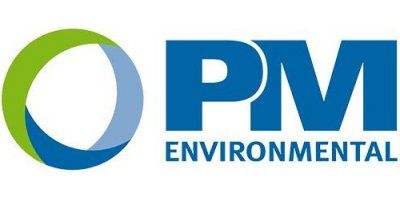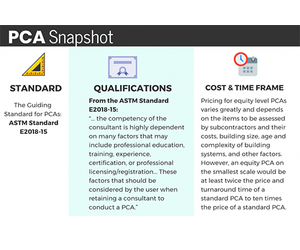

- Home
- Companies
- PM Environmental
- Articles
- Development Series: Standard vs Equity ...
Development Series: Standard vs Equity Property Condition Assessment (PCA) Report
Understand the differences between Property Condition Assessment Reports
If you’re making a significant investment on a piece of property, you will likely want to know if the HVAC will stop working in a year, or if the roof will need replacing in five, or if the cracking in the brick masonry means there is a bigger issue going on structurally.
So how do you go about uncovering these types of issues?
Standard Property Condition Assessment (PCA)
Buying commercial real estate is similar, in some aspects, to buying a house. There is usually a lender involved that has a specific set of requirements that must be met to close on the property. These typically include an appraisal to determine the value of the house. This report, performed by a company chosen by the lender, considers characteristics like gross living space, view and property age in addition to examining recent comparable sales, based on current market conditions of similar properties sold in the last 3-6 months. An Environmental Site Assessment (Phase I ESA) may also be ordered to ascertain the environmental condition of the property. Neither of these reports, however, provides buyers with any information about the condition of the building they are purchasing.
That is where the Property Condition Assessment, or PCA, comes in. Performed by qualified professionals, a PCA involves an on-site visual inspection of a property’s mechanical, electrical, and plumbing systems along with landscaping and site topography and drainage, conveyance systems including lifts, elevators, escalators, fire protection systems, and ADA (Americans with Disabilities Act) accessibility, among other things.
The standard PCA identifies specific deficiencies that require immediate or short-term repair, or deferred maintenance items and provides recommended actions with budgetary costs. The PCA should be performed at the same time as the other assessments being conducted on the property, and before closing.
In some aspects, having a PCA allows prospective buyers greater leverage in negotiating the sale price of the property, especially if deferred maintenance costs are high. The PCA also gives the buyer an understanding of what they may expect in the future.
Equity Level PCA
Now, where does a standard PCA differ from an equity PCA? The assessment within a standard PCA is limited to visual observations, interviews and gathering of available information, whereas the assessment within an equity PCA goes beyond visual observations to include in-depth, investigative diagnostics testing to determine the function and performance of various building systems.
“During an equity PCA, subcontractors and engineers for the various trades are contracted to perform individual assessments on building systems and components,” said Eric Guikema, Architectural Consultant at PM Environmental. “The subcontractors generate their own professional reports with opinions and cost estimates for current and future needs of the systems that they are trained to assess and we, in turn, review their reports, excerpt their costs and recommendations into the equity PCA report, and provide our own opinions, if necessary. The PCA consultant essentially serves as the ‘quarterback’ of the process by contracting and coordinating the subcontractors and delivering a comprehensive report to the client that accurately describes the physical and financial needs of the property.”
During an equity PCA for a high-rise building, dedicated assessments by trade subcontractors are often used to the fullest extent and include assessment of structural, mechanical, electrical, plumbing, fire protection, elevator, roofing and façade systems whereas an equity PCA for smaller properties may have assessments performed on any combination of these systems.
“We also use assessments by trade subcontractors in standard PCAs on a case-by-case basis but not to the full extent that we would during an equity PCA,” said Guikema.
Sometimes, clients will request additional testing beyond the scope of a standard PCA because they have concerns about a building component or they need to meet an internal requirement.
“A client may know that the roof is in poor condition ahead of our assessment and request a roof assessment be done by a roofing contractor in addition to the PCA,” said Guikema. “They want the most accurate cost to replace or they simply want a more detailed opinion than a visual assessment would provide.”

Short-term and Capital Reserve Costs
Both equity and standard PCA reports reflect immediate, short-term and capital reserve costs.
• Immediate needs are typically reported the same in both types of PCA reports and include life/safety hazards and code violations. The short-term needs typically include items of deferred maintenance and replacement of components that are beyond their useful life.
• The short-term needs in an equity PCA also include the costs to address current needs of building systems as recommended by the trade subcontractors. In a standard PCA, a lender may require the borrower to address all immediate and short-term needs prior to close. In both PCAs, the immediate and short-term needs reflect the current needs of the property, but the needs called out in an equity PCA will be more detailed and precise.
• The capital reserve schedule in an equity PCA typically reflects the needs over a short period, typically 5 to 7 years, and includes additional items noted by trade subcontractors that do not need to be addressed currently but that should be addressed in the near future.
• The capital reserve schedule in a standard PCA typically reflects the needs as recommended by the PCA provider during the loan term so that the lender can understand what capital expenses the owner might incur that could prevent them for paying on the loan and when they might occur. The length of the capital reserve schedule is typically dictated by lender requirements, which is normally the length of the loan term plus two years. The additional two years is provided to give foresight on items that may be projected in this time period that could potentially fail or require early replacement near the end of the loan term. The costs and recommendations provided in a standard PCA are not actual requirements but are recommendations of the PCA provider whose completion by the owner are considered “at will”.
Leverage for Purchasers
“A PCA is helpful as a leverage for the purchaser against the seller. This leverage is even greater during an equity PCA, as the costs involved are much higher,” said Victor Tvedten, Architectural Consulting Manager at PM Environmental.
For clients purchasing large properties, both in square footage and monetary value, an equity PCA minimizes the risk of some unpleasant surprises. Going the extra step to ensure all building systems are thoroughly inspected and their current functionality and needs identified not only allows for greater leverage during the buying process, but may save the purchaser a lot of money later on down the road.
